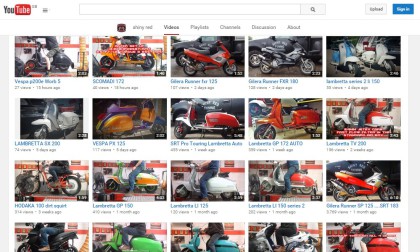Our Dyno
One of the most useful tools we have in our workshop is our Dynamometer. We use it to measure and compare power transfer at different points on the vehicle, thus allowing the engine or transmission to be modified to get more efficient power transfer.
Shiny Red Tuning use the DynaPro S32 model, a small inertia-only type dyno, for use with lower powered machines (up to 50bhp). These dynos are particularly suited for use with mopeds and scooters due to the low drum weight. Eddy brake dynos are more useful for high power motorbikes or when re-mapping ECUs. They are in fact of little use when it comes to setting up carburetted engines. Where small, highly tuned 2 stroke engines are concerned, using an eddy brake runs the risk of putting too much stress on the engine and can easily prove fatal by overloading the engine. Therefore, it is better not to use the eddy brake when tuning high end race spec 2 stroke scooter engines.
Also the S32 has an inertia of only 3.2kg, so the initial force needed to move the drum from stand still is lower than on the larger model dynos, again putting less stress on the engine. As runs are started from 10mph+ the initial pull-off is irrelevant anyway. A lighter drum is especially useful for tuning scooters with CVT transmissions as the heavier drums can run the risk of burning out the clutch just to get the drum rolling.
99% of dynos currently exported to the Malaysian market are the smaller inertia only models, due to the popularity of scooters out there.
The times and speeds achieved on the dyno are not ‘real life’ figures, as they don’t take into account wind resistance, road conditions, etc. However, when comparing one run to another, it is easy for an experienced operator to see where gains have been made and what can be done to improve things further.
In addition to the dyno itself we use an automatic climate monitor. This unit will automatically display on screen temperature, pressure, humidity and relative air density (RAD) and can be used to make adjustments to the final readings (correction factor) so that climate conditions will not affect the final set-up. Therefore we can see the effect of modifications, before and after, even if the comparison runs are done on different days with different climatic conditions. The results are effectively ‘corrected’ as if it was the ‘perfect’ day.
Another very useful tool we have is the air/fuel gas analyser, the only true way to jet a vehicle. All air/fuel data can be displayed in real-time or plotted against power, torque, RPM etc, to enable us to see if the engine is running rich/lean at each point and to make adjustments to suit.
If you wish to make an appointment please contact us by phone, email, or using the form on our contacts page.
100s more videos are available to viewon our YouTube channel. CLICK HERE





















